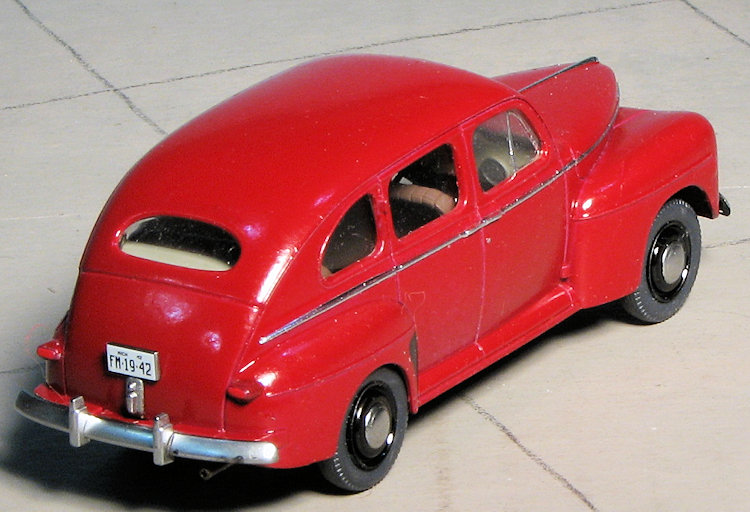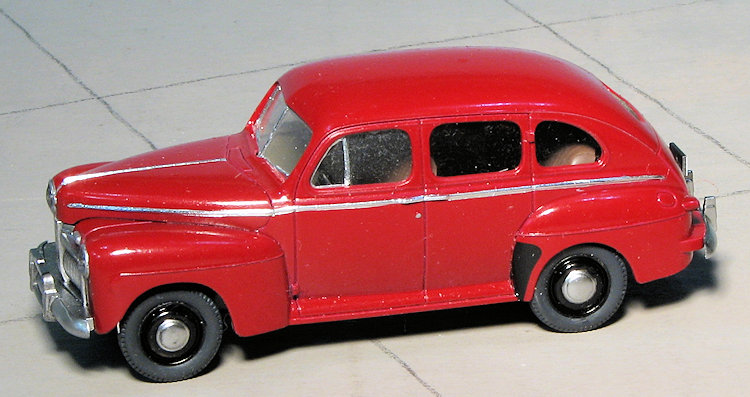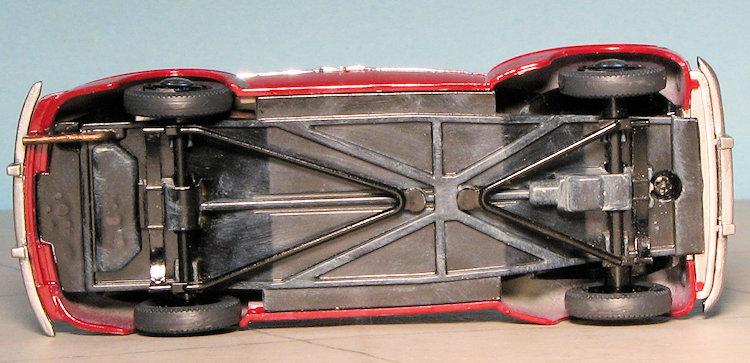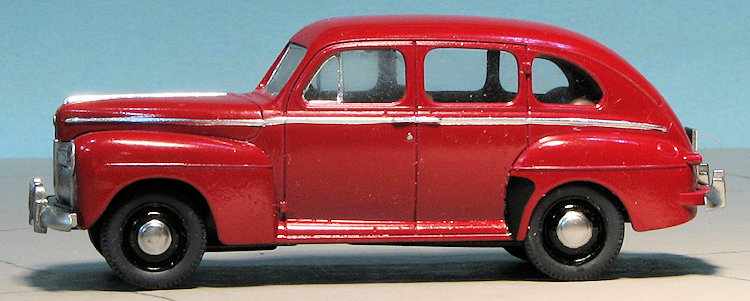
Tamiya 1/48 1942 Ford
| KIT #: | 32559 |
| PRICE: | $37.00 SRP |
| DECALS: | One option |
| REVIEWER: | Scott Van Aken |
| NOTES: |

| HISTORY |
The Ford car was thoroughly updated in 1941, in preparation for a time of unpredictability surrounding World War II. The 1941 design would continue in an aborted 1942 model year and would be restarted in 1946 and produced until the more modern 1949 Fords were ready. During the initial year of this car, it evolved considerably. The front fenders came in three pieces, the theory being that small damage could be replaced easily. During the year, it evolved into 2 pieces with the lower front and back sections being joined. The hood risers changed, the early ones being the same as 1940 Fords, changing during the year to the better later version. In the 1941 Convertible, there were no rear side windows, the only side windows being in the doors, in 1942, quarter windows were added so the rear occupants could see out. There were five different coil/distributor arrangements during 1941, causing confusion for mechanics. Other variations were: two different positions for the generator, and three for the cooling fan — front of the crankshaft, front of the generator (rare) and on a bracket. This is thought to be the first Ford to offer an oil filter. There were two interior heaters: a "Southwind" gasoline burner, which had the advantage of keeping you warm in winter at drive-in movies (provided you added a small electric fuel pump), and a more ordinary hot-water type. Both had window defrosters. It had an excellent radio, which could consume the battery in about 2 hours. Electric windshield wipers were available in addition to the vacuum-powered wipers. There were three different convertible power top mechanisms (vacuum, electric screw, and hydraulic), and two different header bar latching systems. Rear suspensions sometimes had a sway bar, most did not. It had excellent brakes for the era, and the best handling of an ordinary car at the time. It was a very transitional car.
 The two previous Ford car lines,
standard and De Luxe, had blossomed into three, Special, De Luxe, and Super
De Luxe. This time, the entry-level 136 CID (2.2 L) V8 was deleted in favor
of a new 226 CID (3.7 L) L-head
straight-6, the first Ford six since the failed 1906 Model K. The popular
221 CID (3.6 L) V8 remained as the top-line engine and was standard in De
Luxe models. Both engines were rated at 90 hp. The 239 CID engine,
introduced in 1939 for Mercury and Trucks, was continued in the Mercury
Models. The chassis was longer, with a 114 in (2896 mm) wheelbase.
The two previous Ford car lines,
standard and De Luxe, had blossomed into three, Special, De Luxe, and Super
De Luxe. This time, the entry-level 136 CID (2.2 L) V8 was deleted in favor
of a new 226 CID (3.7 L) L-head
straight-6, the first Ford six since the failed 1906 Model K. The popular
221 CID (3.6 L) V8 remained as the top-line engine and was standard in De
Luxe models. Both engines were rated at 90 hp. The 239 CID engine,
introduced in 1939 for Mercury and Trucks, was continued in the Mercury
Models. The chassis was longer, with a 114 in (2896 mm) wheelbase.
The "ignition key" for these cars was actually used to operate a bolt lock which, on one end, unlocked the steering column (a feature destined to return, mandated, decades later), and on the other end unblocked the ignition switch, allowing it to be operated. Starting the car was then accomplished by pressing a pushbutton on the dashboard, another feature destined to return with the advent of "smart keys."
Although starting cranks had been replaced by electric starters for decades, Ford cars included a manual starting feature until 1948 as an antidote to dead-battery syndrome. The wheel-lug wrench served as a handle (also for the jack) and the jack shaft with bayonet-coupling pins could be inserted through a small hole in the grille to engage a bayonet socket on the forward end of the engine crankshaft. A quick-and-easy twist of the handle was sufficient to start the flat head V8, and the bayonet coupling was self-disengaging for safety.
 Ford
halted its car and truck lines on February 10, 1942 to begin war production,
but not before a short run of 1942 cars was built. Changes were made to the
car besides a three-part "electric shaver" grille — and the parking lights
were moved from the top of the fenders to between the grill and headlights.
Tail lights were enlarged and moved from vertical to horizontal. the frame
was lowered and softer springs were used to improve the ride. The dashboard
was changed, moving the radio from the top of the dash to low down, and the
linear speedometer and clock were replaced with round ones. The radio had an
optional floor button so you could change preselected stations without
moving your hands. War rationing required auto makers to black out their
chrome trim, and a special four-door model was produced with no chrome at
all for military use. The pickup received new styling as well, with heavy
vertical bars, and truck production lasted through March 3.The photo is of
the De Luxe model; the Super De Luxe having considerably more chrome.
Ford
halted its car and truck lines on February 10, 1942 to begin war production,
but not before a short run of 1942 cars was built. Changes were made to the
car besides a three-part "electric shaver" grille — and the parking lights
were moved from the top of the fenders to between the grill and headlights.
Tail lights were enlarged and moved from vertical to horizontal. the frame
was lowered and softer springs were used to improve the ride. The dashboard
was changed, moving the radio from the top of the dash to low down, and the
linear speedometer and clock were replaced with round ones. The radio had an
optional floor button so you could change preselected stations without
moving your hands. War rationing required auto makers to black out their
chrome trim, and a special four-door model was produced with no chrome at
all for military use. The pickup received new styling as well, with heavy
vertical bars, and truck production lasted through March 3.The photo is of
the De Luxe model; the Super De Luxe having considerably more chrome.
It is certain that 1942-style Ford cars continued to be produced as military staff cars from March 1942 through summer 1945. These would have been registered as 1942, 1943, 1944, and 1945 models. Additionally, a large number of 1942 (and a few 1941) cars held in dealer stocks by government edict, to be doled out to essential users during the conflict, were Fords. Some states titled cars by the year of sale, so it is possible to find 1943, 1944, and 1945 models by virtue of their registrations and titles.
| THE KIT |
 The kit was initially produced as an add-on to a P-51 Mustang kit and
rather accurately portrays a 1942 Ford four-door sedan. Thanks to it
being a military version, there is no chrome at all. While the side
of the box shows a civilian version, the instructions made no
mention of it and you'd have to do the chrome bits in paint if you
so wished.
The kit was initially produced as an add-on to a P-51 Mustang kit and
rather accurately portrays a 1942 Ford four-door sedan. Thanks to it
being a military version, there is no chrome at all. While the side
of the box shows a civilian version, the instructions made no
mention of it and you'd have to do the chrome bits in paint if you
so wished. | CONSTRUCTION |
 I decided from the start to build this as a civilian car. The decal
sheet contains a pair of license plates that would be appropriate, but
the kit would require a bit of work to meet those standards. The
military car is devoid of chrome, but the standard vehicle would have
quite a bit of chrome trim. I did a lot of sleuthing on the internet to
see what I would have to do. Not surprisingly, the first thing I did was
painting.
I decided from the start to build this as a civilian car. The decal
sheet contains a pair of license plates that would be appropriate, but
the kit would require a bit of work to meet those standards. The
military car is devoid of chrome, but the standard vehicle would have
quite a bit of chrome trim. I did a lot of sleuthing on the internet to
see what I would have to do. Not surprisingly, the first thing I did was
painting. At the body, I had decided to save myself a lot of work and model the De
Luxe version of the car which had minimal chrome trim. The Super De Luxe
had the side and rear window opening trim in chrome as well as some
strips on the fenders. Not having to do those saved me a lot of time. I
did, however, have to chrome the windshield surrounds and the vent
windows. For all this, I used Bare Metal Foil chrome. One really uses
quite a bit of this for even the smallest item as it is imperative that
all the area gets covered at one time to eliminate the issue of tiny
seams.
At the body, I had decided to save myself a lot of work and model the De
Luxe version of the car which had minimal chrome trim. The Super De Luxe
had the side and rear window opening trim in chrome as well as some
strips on the fenders. Not having to do those saved me a lot of time. I
did, however, have to chrome the windshield surrounds and the vent
windows. For all this, I used Bare Metal Foil chrome. One really uses
quite a bit of this for even the smallest item as it is imperative that
all the area gets covered at one time to eliminate the issue of tiny
seams. | CONCLUSIONS |
 ntests
against real car modelers, but it looks nice enough to me. I am sure
I missed something in trying to civilianize this one, but really did
not want a boring OD staff car. One would hope that Tamiya will
continue doing things like this as I like the scale and it is close
enough to my 1/43 car builds that it doesn't look too out of place
even if it is smaller in scale.
ntests
against real car modelers, but it looks nice enough to me. I am sure
I missed something in trying to civilianize this one, but really did
not want a boring OD staff car. One would hope that Tamiya will
continue doing things like this as I like the scale and it is close
enough to my 1/43 car builds that it doesn't look too out of place
even if it is smaller in scale. | REFERENCES |
http://en.wikipedia.org/wiki/1942_Ford
February 2016
My thanks to me for picking this one up.
If you would like your product reviewed fairly and fairly quickly, please contact the editor or see other details in the Note to Contributors.